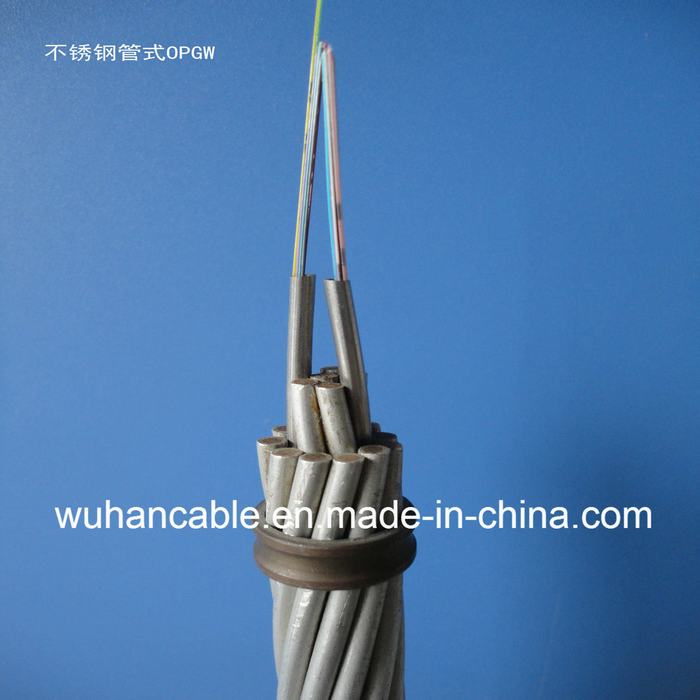OPGW ADSS OPPC Optical Fiber Cable

Quick Details
Product Details
Because of the wide variety of conditions to which they are exposed, optical
fibers have to be encased in several layers of protection. The first of these layers is
a thin protective coating made of ultraviolet curable acrylate (a plastic), which is
applied to the glass fiber as it is being manufactured. This thin coating provides
moisture and mechanical protection.
The next layer of protection is a buffer that is typically extruded over this
coating to further increase the strength of the single fibers. This buffer can be
either a loose tube or a tight tube. Most data communication cables are made
using either one of these two constructions. A third type, the ribbon cable, is fre-
quently used in telecommunications .
Loose-tube (loose-buffer) cable is used mostly for long-distance applications
and outside plant installations where low attenuation and high cable pulling
strength are required. Several fibers can be incorporated into the same tube, pro-
viding a small-size, high-fiber density construction. The cost per fiber is also
lower than for tight-buffered cables. The tubes may be filled with a gel or
wrapped in an absorbent tape, which prevents water from entering the cable and
offers additional protection to the fibers. Since these cables must be terminated
either by fusion splicing to preconnectorized pigtails or by using breakout kits,
they are more cost-effective for longer-distance applications than they are for
short-distance applications. The fibers are completely separated from the outside
environment. Therefore, the loose-tube cables can be installed with higher pulling
tensions than tight-buffered cables.
A tight-buffered cable design is better when cable flexibility and ease of
termination are a priority. Most inside cables are of the tight-buffered design
because of the relatively short distances between devices and distribution racks.
Military tactical ground support cables also use a tight-buffered design because
of the high degree of flexibility required. A tight-buffered fiber can be cabled with
other fibers, and then reinforced with Kevlar™, and jacketed to form a tightpack
(distribution) cable. Another option is to individually reinforce each fiber with
Kevlar, then jacket it. Several single fiber units can then be cabled together to
obtain a breakout-style cable where each fiber can be broken out of the bundle
and connectorized as an individual cable.
A ribbon-style cable consists of up to 12 coated fibers bonded to form a rib-
bon. Several ribbons can be packed into the same cable to form an ultra-high-
density, low-cost, small-size design. Over 100 fibers can be put into a 1/2-inch
square space with ribbon cables. Ribbon fibers can be either mass fusion spliced
or mass terminated into array connectors, saving up to 80 percent of the time it
takes to terminate conventional loose or tight-buffer cables.
Cable Jacketing
The materials used for the outer jacket of fiber optic cables not only affect the
mechanical and attenuation properties of the fiber, but also determine the suit-
ability of the cable for different environments, and its compliance to various
National Electric Code (NEC) and Underwriters Laboratories (UL) requirements.
A cable that will be exposed to chemicals can utilize an inert fluorocarbon
jacket such as Kynar, PFA, Teflon FEP, Tefzel, or Halar. These materials are suit-
able for a very wide range of applications, although they may be too stiff for
some industrial applications.
Aerospace applications require that the cables be able to withstand a wide
temperature range and be routed through the cramped environment of an air-
craft. These cables are frequently rated for continuous operation from -65°C to
+200°C, are less than 1/10 inch in size, and can sustain a bend radius of 1/2 inch.
Fire safety is a major issue. Cables used in an industrial environment, such as
a power plant, are usually placed in horizontal trays. Several cable trays may be
stacked in close proximity. In the event of a fire, both horizontal fire propagation
and the ignition of lower cable trays by the dripping of flaming outer jacket ma-
terial must be prevented. An irradiated Hypalon or XLPE jacket will meet
the flame spread requirements (IEEE-383, 1974). When exposed to a flame, the
jacket material will char rather than melt and drop burning material, thus
preventing the ignition of cables in lower trays. Inside premises cables have to
meet the requirements of the NEC Article 770. The outer jacket selection is essen-
tial to ensure compliance to the flame and smoke requirements.
Environmental and Mechanical Factors
Aside from buffer type, jacketing system, and flammability requirements, the
cable design also must be based on the mechanical and environmental conditions
that will be encountered throughout the system’s life span.
A cable that will be pulled through conduits, ducts, or cable trays will have to
incorporate a number of strength members and stiffening elements to add tensile
strength and to prevent sharp bends from damaging the fibers. The addition of
Kevlar increases the cable tensile strength. Kevlar can either be braided or longi-
tudinally applied underneath the cable or fiber component jackets. The central
strength member also serves both as a filler around which the fiber components
are cabled and as a strength member when it incorporates steel, Kevlar, or epoxy
glass rods. Another function of the epoxy glass central member is to act as an
antibuckling component, counteracting the shrinkage of the jacketing elements at
low temperatures and preventing microbends in the fibers. An epoxy glass rod
central member should always be used in cables that may be exposed to tempera-
tures below 0°C.
- Next: Overhead Bare Stranded Aluminum Conductor Steel Reinforced ACSR Conductor
- Previous: Rated Voltage 0.6/1kv (um=1.2kV) Wrapped Insulated Multi-Functional Frequency Conversion Cable
Contact us
Similar Or Related
- No related articles



